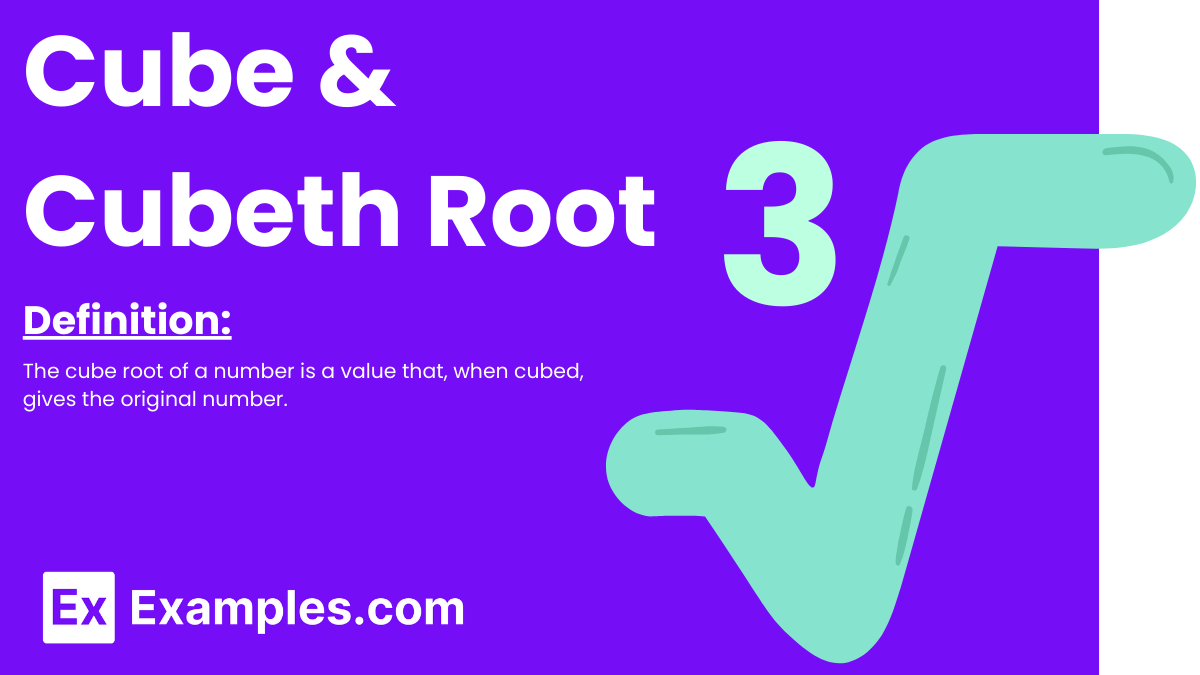What is the cube of 3?
6
9
27
81


A cube of a number is the result of multiplying that number by itself three times. It is expressed mathematically as 𝑛³ , where 𝑛ⁿ is any real number. For example, the cube of 4 is 4³
The cube root of a number is a value that, when cubed, gives the original number. It is denoted as 𝑛3. For instance, the cube root of 64 is ³√64=4, because 4³ =64
Cubes and cube roots possess unique mathematical properties that are essential for both theoretical studies and practical applications. Here are the key properties for each:
Preservation of Sign:
Odd and Even Nature:
Sum of Cubes Formula:
Multiplicative Property:
Inverse Operation:
Behavior with Negative Numbers:
Distribution over Multiplication:
Root of a Fraction:
Continuity:
The cube root of a number 𝑎 provides a value 𝑏 such that when 𝑏 is cubed, it returns 𝑎. Mathematically, this relationship is expressed as: ³√𝑎=𝑏This equation holds true under the condition that: 𝑎=𝑏³This relationship is particularly useful when determining the cube root of perfect cubes, where 𝑎 and 𝑏
| Number | Cubes |
|---|---|
| 1 | 1 |
| 2 | 8 |
| 3 | 27 |
| 4 | 64 |
| 5 | 125 |
| 6 | 216 |
| 7 | 343 |
| 8 | 512 |
| 9 | 729 |
| 10 | 1000 |
| Number | Cube Root (3√) |
|---|---|
| 1 | 1.000 |
| 2 | 1.260 |
| 3 | 1.442 |
| 4 | 1.587 |
| 5 | 1.710 |
| 6 | 1.817 |
| 7 | 1.913 |
| 8 | 2.000 |
| 9 | 2.080 |
| 10 | 2.154 |
| 11 | 2.224 |
| 12 | 2.289 |
| 13 | 2.351 |
| 14 | 2.410 |
| 15 | 2.466 |
| 16 | 2.520 |
| 17 | 2.571 |
| 18 | 2.621 |
| 19 | 2.668 |
| 20 | 2.714 |
| 21 | 2.759 |
| 22 | 2.802 |
| 23 | 2.844 |
| 24 | 2.884 |
| 25 | 2.924 |
| 26 | 2.962 |
| 27 | 3.000 |
| 28 | 3.037 |
| 29 | 3.072 |
| 30 | 3.107 |
Begin by breaking down the number into its prime factors. This involves dividing the number by the smallest prime number (starting with 2) and continuing the process with the quotient until only prime numbers are left.
Organize the resulting prime factors into groups, each containing three identical factors. This step is crucial because the cube root of a number will be the product of factors from each group.
Multiply one factor from each group to find the cube root. If any factors remain that cannot be grouped into threes, then the number is not a perfect cube, and an exact cube root (in whole numbers) cannot be determined.
Solve the equation 2𝑥−6=16
Answer: Add 6 to both sides: 2𝑥=22 Divide by 2: 𝑥=11Final Answer: 𝑥=11
Calculate the compound interest on $1000 for 2 years at an annual interest rate of 5%, compounded annually.
Answer: Use the formula for compound interest: 𝐴=𝑃(1+𝑟)𝑛A=P(1+r)n Where:
Calculate:
𝐴=1000(1+0.05)²
𝐴=1000(1.05)² 𝐴=1000×1.1025=1102.5
Final Answer: The compound interest is $1102.5.
Convert 68°F to Celsius using the formula 𝐶=5/9(𝐹−32)C=95(F−32).
Answer: Plug in the Fahrenheit value: 𝐶=5/9(68−32)
𝐶=5/9(36)
𝐶=20
Final Answer: 20°C
A cube is a number raised to the power of three, expressed as 𝑛³. A cube root is the inverse, finding a number 𝑛n that when cubed gives the original number, denoted as ³√×
The cube root formula to find 𝑛n from 𝑛³=𝑥 is expressed as ³√× = nIt calculates the number 𝑛 whose cube equals 𝑥.
The cube root of 729 is 9, since 9³=729 This means ³√729=9.
The cube of 4 is 64, calculated as 4³=4×4×4=64
Cubes from 1 to 10 are: 1, 8, 27, 64, 125, 216, 343, 512, 729, and 1000. These represent 𝑛³ for 𝑛n from 1 to 10.
No, 30 is not a cube number. There is no integer 𝑛n such that 𝑛³=30. The cube numbers closest to 30 are 27 (3³) and 64 (4³)
Text prompt
Add Tone
10 Examples of Public speaking
20 Examples of Gas lighting
What is the cube of 3?
6
9
27
81
Which number is the cube root of 64?
3
4
5
7
What is the cube of 5?
15
25
125
150
Which number has a cube root of 9?
27
81
1000
729
Find the cube root of 1000.
10
20
30
40
What is the cube of 7?
49
56
343
700
Which number is the cube root of 27?
2
3
5
6
What is the cube of 2?
4
6
8
10
Which number has a cube root of 64?
8
16
32
43
Find the cube of 10.
100
1000
10000
100000
Before you leave, take our quick quiz to enhance your learning!

